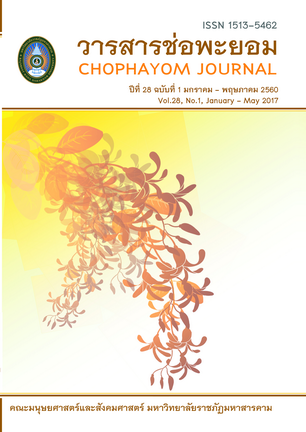สิทธิในไม้หวงห้ามนอกเขตป่า Rights in Reserved Timber Species Outside the Forest Areas
Abstract
บทคัดย่อ
ป่าไม้ถือว่าเป็นทรัพยากรธรรมชาติที่มีผลเกี่ยวเนื่องต่อทรัพยากรธรรมชาติอย่างอื่นซึ่งมีคุณค่าและมีประโยชน์ต่อประเทศชาติและประชาชน หากพื้นที่ป่าไม้ของชาติลดน้อยลงย่อมมีผลกระทบต่อชีวิตความเป็นอยู่ของประชาชน ปัจจุบันแนวโน้มพื้นที่ป่าไม้ของประเทศไทย ได้ลดตํ่าลงทุกปี โดยตํ่ากว่าเป้าหมายตามนโยบายป่าไม้แห่งชาติ คือร้อยละ 40 ของพื้นที่ประเทศ ซึ่งภาครัฐโดยหน่วยงานที่เกี่ยวข้องได้พยายามวางมาตรการในอนุรักษ์ป้องกันรักษาพื้นที่ป่าไม้ที่คงเหลืออยู่ให้คงไว้ ควบคู่ไป กับการส่งเสริมให้ประชาชนช่วยกันปลูกฟื้นฟูป่าในที่ของรัฐในรูปแบบต่าง ๆ รวมทั้งการส่งเสริมให้เอกชนปลูกต้นไม้มีค่าทางเศรษฐกิจในที่ดินของเอกชนด้วยอันเป็นการช่วยเพิ่มพื้นที่สีเขียว โดยผืนป่าของเอกชนอีกทางหนึ่งมาตรการที่รัฐบาลออกมาเพื่อเสริมประสิทธิภาพในการอนุรักษ์ รักษาพื้นที่สีเขียวอีกทางหนึ่ง คือ ได้มีประกาศคณะรักษาความสงบแห่งชาติฉบับที่ 106/2557 ลงวันที่ 21กรกฎาคม พุทธศักราช 2557 เรื่อง แก้ไขเพิ่มเติมกฎหมายว่าด้วยป่าไม้ ซึ่งเดิมตามพระราชบัญญัติป่าไม้ พ.ศ. 2484 มีชนิดไม้เพียงสองชนิดคือ ไม้สัก และไม้ยาง ไม่ว่าขึ้นอยู่ที่ใดให้ถือว่าเป็นไม้หวงห้าม แต่ตามประกาศคณะรักษาความสงบแห่งชาติฉบับดังกล่าว ได้มีการแก้ไขเพิ่มเติมให้มีชนิดไม้มีจำนวนเพิ่มมากขึ้นอีก ซึ่งแม้ว่าไม้ชนิดดังกล่าว จะขึ้นอยู่ในที่ดินกรรมสิทธิ์ที่มีโฉนดที่ดินของเอกชน ก็ต้องถือว่า เป็นไม้หวงห้าม ต้องได้รับการอนุญาตจากทางราชการ โดยชนิดไม้ที่เพิ่มขึ้นอีก คือไม้ชิงชัง ไม้เก็ดแดง ไม้อีเม่ง ไม้พยุงแกลบ ไม้กระพี้ ไม้แดงจีน ไม้พยุง ไม้กระซิก ไม้กระซิบ ไม้พะยูง ไม้หมากพลูตั๊กแตน ไม้กระพี้เขาควาย ไม้เก็ดดำ ไม้อีเฒ่า และไม้เก็ดเขาควาย โดยไม้ชนิดดังกล่าว ไม่ว่าจะขึ้นอยู่ที่ใดในราชอาณาจักร เป็น ไม้หวงห้าม ประเภท ก.
ดังนั้น การกำหนดให้ไม้ชนิดดังกล่าวเป็นไม้หวงห้าม ซึ่งการทำไม้ การตัดไม้ จะต้องได้รับการอนุญาตจากทางราชการ เห็นว่า เป็นนโยบายและมาตรการที่ไม่เหมาะสม ไม่สอดคล้องกับหลักการการมีส่วนร่วมของประชาชน เพราะในการบริหารจัดการทรัพยากรธรรมชาติ โดยเฉพาะป่าไม้ ต้องได้รับความร่วมมือจากประชาชนโดยผ่านกระบวนการการมีส่วนร่วมของประชาชนผู้ที่มีส่วนเกี่ยวข้องในพื้นที่ จึงจะก่อให้เกิดแรงบันดาลใจ ลงทุนลงแรงสร้างป่าโดยการปลูก บำรุง ดูแลรักษา จัดการโดยเอกชนนอกจากนั้นแล้ว มาตรการดังกล่าวไม่สอดคล้องกับหลักสิทธิมนุษยชน หลักการสิทธิพลเมือง หลักการสิทธิในทรัพย์สินหลักกรรมสิทธิ์ และหลักการเรื่องสิทธิในทรัพย์ส่วนควบซึ่งไม่ก่อให้เกิดความรักหวงแหน หรือแรงจูงใจต่อต้นไม้ในการที่จะปลูก บำรุงรักษา บริหารจัดการเพราะคิดว่าต้นไม้นั้นอาจกลายเป็นไม้หวงห้ามของรัฐ ทั้งการขออนุญาตตัดไม้ดังกล่าวก็มีกระบวนการทางกฎหมาย ระเบียบ และขั้นตอนที่ยุ่งยากและล่าช้า ดังนั้น มาตรการดังกล่าวอาจเป็นอุปสรรคต่อการสร้างแรงจูงใจในการปลูกป่าและการบริหารจัดการป่าโดยเอกชนซึ่งจะทำให้การเพิ่มพื้นที่ป่าโดยเอกชนไม่บรรลุเป้าหมาย คำสำคัญ : สิทธิ ,ไม้หวงห้ามนอกเขตป่า,ป่า
ABSTRACT
Forests are natural resources accordingly affecting other kinds of natural resources in which being valuable things and also providing the great worth and use to Thailand and Thai
people. When the forest areas have gradually been decreasing, impacts to secure sustainable livelihoods will be occurred. Currently a total forest area tends to be reduced every year. Currently the protection and restoration of protected areas and stopping encroachment and destruction of forest resources is an important policy of the Government. A target for reclamation of forest land has been set at an estimated forest cover of 40% of a total land area of Thailand. Government sectors rendered reservation regulations to prevent and protect to maintain the forest meanwhile to help enhance the people in each area to plant and recover the forest areas and the non-government sectors to plant the valuable timber in their own lands to fulfill the evergreen lands of Thailand. The Announcement of the National Council for Peace and Order (NCPO) No. 106/2557, 21st July, 2014, has recently been legislated to execute the regulations and measurements for
preservation the evergreen lands following the Forestry Act B.E. 2484 (1941) and its latest amendment that declared only two reserved timber species: Teaks and Dipterocarps (in Thai called yang - resin). These two species of timber were strictly reserved wherever they grown up. However, under NCPO, the measurements have been amended to accrue the timber species to be more reserved even though they have probably been grown inside the private sectors’ lands. These other newly reserved timber species were as follows: Ching-Chung, Ged-Daeng, E-Meng, Payoong-Glaeb, Krapee, Daeng-Chin, Kayoong, Krasik, Krasib, Payoong, Makplu-Taktaen, Krapee-Kaokwai, Ged-Dum, E-Thao, and Ged-Kaokwai. These species will be determined as the first forbidden rank of reservation. According to the determination of these timber types as reserved, the logging and forestry are officially necessary to ask for the permission from the government sectors. By this, the government policy and inappropriate measures will inconsistently manipulate the people with implementation to be expedited. Considering natural resources administration and management, the process of the locals’ participation in each area is required to conform the activities to help raise the motivation, restoration, reclamation from the private sectors. Besides, the measures as mentioned were not congruent with the relevant principles such as human rights, fundamental rights of people, rights of property, ownership or titles, and coexisting component part rights. In addition, this will not cause and produce the effective sense of belonging or motivation for maintenance and administration and management. Main reasons were complicated and delayed process of laws, regulations and procedures about asking permission to deal with the reserved timber. The people would think that such species of timber were still reserved. So these measures likely were the obstacles and problems to increase trees in the preserved forests and the natural resources administration and management of the private sectors would not reach their goals. Keywords : rights, reserved timber species outside of the forest areas






